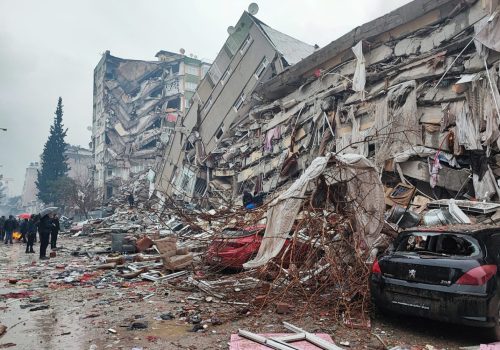I work in Syrian civil society. There were gaps in our performance after the February 6 earthquake.
When people imagine a natural disaster, they often picture destruction and loss. However, there is an implicit political meaning many overlook. As defined by the United Nations Office for Disaster Risk Reduction, a disaster is a “situation in which hazard and vulnerability intersect leading to damage or potential damage exceeding the coping capability of those affected without outside support.” This fragility is the consequence of a government’s policies, such as negligence or the failure to apply laws, prepare for emergencies, or learn from mistakes, which can cause harm to a populace.
The February 6 earthquake in Turkey and Syria reflects this political dimension clearly, especially in northwest Syria, where there were over 5,900 deaths and eleven thousand injuries. Neither the de facto authorities nor local actors—such as Syrian non-governmental organizations (NGOs)—were able to provide the required emergency services to keep more than five million people alive, which was exacerbated by the poor and slow response from the international community and international NGOs.
Syrian NGOs during a disaster
The case of Syrian NGOs calls for further study. Since the 2011 civil war began, they emerged in abnormal circumstances under conflict, developed very quickly, and had to deal with the absence of a government response and the vast needs resulting from military operations and forced displacement waves. Despite such realities, these NGOs were somehow able to quickly address the effects of the earthquake while being one of the parties most affected by the disaster.
Syrian NGO offices are mostly concentrated in areas where the earthquake struck, such as Turkey’s Gaziantep and Hatay provinces. Some NGO employees and their families ended up becoming victims as a result. Others suffered from instability. Despite this, they arranged their affairs within a short period and designed the required response for the affected people in northern Syria.
However, notwithstanding their brave efforts, there were many gaps in their response due to faults in organizational structure, policies, and management. It may seem harsh to make criticisms in these circumstances, but introspection is necessary to learn from these mistakes and avoid repeating them. The Syrian humanitarian NGOs’ responses reflected many gaps that are supposed to be remedied in their structure, policies, and management. It was evident that there was a lack of expertise and qualified cadres to deal with disaster situations, who had access to courses—offered by the international community—that did not focus on this aspect effectively.
The cadres of international NGOs—particularly the United Nations Office for the Coordination of Humanitarian Affairs (OCHA —were not in a better position. Emergency responses were absent from these offices, which were located on the other side of the border, and aid was delayed for days—something that is considered to be a crucial flaw in a rescue operation. Moreover, the assistance provided—food and tents—did not initially include items of priority, such as heavy equipment to clear rubble, specialized teams to assist in rescue missions, and medical aid to treat the wounded.
When comparing this poor United Nations response to that of the Haiti earthquake in 2010, the differences are evident, although the conditions are similar. The OCHA office in Haiti was heavily impacted, yet the staff was mobilized with the help of the international community and its NGOs to support the three-month response. In addition, adequate humanitarian action was taken, exhibited by the collection and disbursement of funds three days after the earthquake occurred and the arrival of hundreds of organizations.
Thus, an important question arises: Why did the response of the UN cadres not live up to expectations despite their field experience and previous recommendations to develop disaster responses?
Chaos and poor response
From monitoring the forms of humanitarian response the Syrian NGOs took, I identified chaos as the prominent feature, especially in the first week. For example, the NGOs completely failed to activate the existence of local humanitarian networks, which include dozens of international NGOs. Each organization designed its response individually and launched the same activities without having a clear strategy regarding the utilization of available resources, leading to duplication and waste in providing in-kind assistance and meals. Communication and coordination to improve the response took a long time in these critical hours.
The powerful collaboration between Syrian humanitarian local networks did not emerge except in advocacy activities and via political pressure. As a result, this showed the actual effect of networks in coordinating work on the ground and managing dozens of new volunteer teams that launched humanitarian activities without having any of the required experience.
The earthquake response caused a decline in Syrian NGOs’ reputations. People were divided between those who supported the NGOs’ work and praised their experience and those who questioned the NGOs and demanded that donors deliver their donations directly to people in need. Although this division came to the fore due to this natural disaster, it is not new and cannot continue to be ignored. That is why this case needs to be studied in greater depth. It is imperative that we restore the Syrian public’s confidence in these organizations.
The disaster also revealed other flaws, according to my evaluation. The risk management of humanitarian organizations and international donors extended to nothing more than warehouses storing foodstuffs. There was an acute shortage of rescue machinery and equipment, specialized medical materials, and fuel, and the process of securing and purchasing aid was confusing during this chaos. Moreover, the absence of prior preparation and the lack of experience in dealing with this type of calamity caused a lot of improvisation and uncertainty.
Lessons learned from the disaster response
It is often the case that the focus during and after a natural disaster is on losses or physical destruction, while the weaknesses of the society in question, which surfaced during the event, is ignored. This creates the potential for new disasters that will intensify the disadvantages of a society and exacerbate the problems in its aftermath mainly due to the weakness and fragility of government policies.
The international community and its NGOs bear a large part of the responsibility for the losses incurred by the earthquake in northwest Syria. They have led a cross-border humanitarian response since 2014 and possess the expertise and qualifications to help local communities and NGOs get out of the aforementioned weakness cycle. During these eight years, relief and in-kind aid—such as cartons containing foodstuffs, clothes, or hygiene baskets—have plunged these communities into new levels of vulnerability, by increasing their dependence without helping them to reach self-sufficiency or building their capacity. The international responses have exhausted local authorities, councils, and professional syndicates from emergency response procedures instead of investing in building their capabilities and training them effectively, thus producing cadres with insufficient experience and tools. Consequently, the local councils were highly unprepared to take the initiative, manage responses, and reduce the chaos of the disaster.
On the other hand, the response of the UN, international NGOs, and Arab countries was shameful, as they sided politically with the Bashar al-Assad regime and ignored the most fragile and needy areas. These actors delivered the majority of aid through the regime and the organizations founded by the security apparatus of the Syrian regime. According to the Syrian Network for Human Rights’ report, 90 percent of the aid intended for earthquake victims was stolen.
Such corruption, which ignored opposition areas and left them mired in cycles of weakness and need, could stir up the conflict again and renew military operations. The financial and diplomatic activities that occurred under the guise of “disaster diplomacy” have broken the Assad regime’s international isolation and secured funding that it can use to regain control of northwest Syria.
From these mistakes, it is clear that humanitarian response planning in Syria requires a full review process that reconsiders existing approaches and involves local partners while listening to their experiences. A good place to start would be to redesign the risk management training provided to NGOs and local communities, as well as providing them with capacity-building projects. This way, those on the ground will be empowered to carry out their own affairs, enhance their own stability, and break out of the cycle of weakness to stand prepared for any disaster that may come.
Kenda Hawasli is the director of the social unit at the Syrian Dialogue Centre based in Istanbul, Turkey.
Further reading
Thu, Feb 9, 2023
In Syria, the earthquake ‘did what the Assad regime and Russians wanted to do to us all along’
MENASource By Arwa Damon
While aid increasingly flows into Turkey from around the world by air, land, and sea, areas on the other side of the border in Syria’s rebel-controlled areas are seeing none of that.
Fri, Jun 9, 2023
Assad is appointing new military officials to escape sanctions on Syria
MENASource By
Of the thirty Syrian army and security officers in new leadership positions, only two are blacklisted. This indicates a significant gap.
Mon, Feb 6, 2023
Experts react: How the world should respond to the devastating earthquake in Turkey
New Atlanticist By
How can the international community help? What will the impact be for a region already reeling from a decade-long war and refugee crisis?
Image: Rescue workers searching through the rubble of buildings in the rebel-held town of Jindayris on February 9, 2023, three days after a deadly earthquake that struck both Turkey and Syria.(Photo by Rami Alsayed/NurPhoto)NO USE FRANCE


